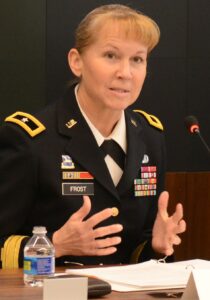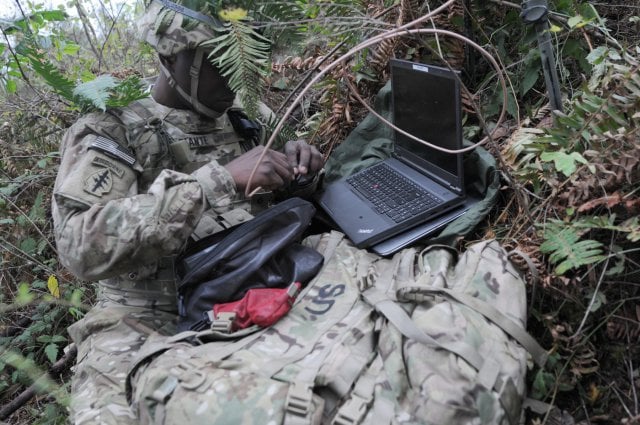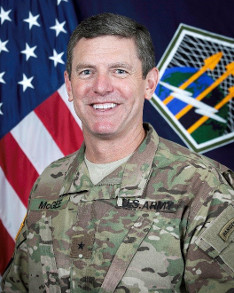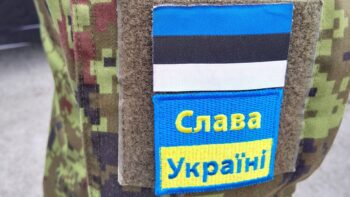
Electronic Warfare Planning & Management Tool (Army concept)
PENTAGON: The Army is ahead of schedule building cyber teams — but its equally essential electronic warfare branch is lagging badly. Like a fiddler crab, one arm is much more developed than the other. While effective in the current fight against Daesh (aka ISIL), this unbalanced force would be at a severe disadvantage in future Multi-Domain Battles the Army envisions against a sophisticated adversary such as Russia, which excels in both cyber and electronic warfare.

Brig. Gen. Patricia Frost
On the cyber side, the Army expects to have its 41 National Mission Force teams fully operational by the end of 2017. (30 are currently at Full Operational Capability; the other 11 are at Initial Operational Capability). That’s ahead of the 2018 deadline, noted Brig. Gen. Patricia Frost, who holds the new position of cyber director on the Army staff.
But even that pace doesn’t sate the demand for cyber teams. “As soon as we are creating them, they are being put into operational use… defensive and offensive,” said Brig. Gen. J.P. McGee. deputy commander for operations at US Army Cyber Command. Defensive teams protect the Department of Defense Information Network (DODIN) against hackers as soon as they reach Initial Operational Capability, McGee and Frost told reporters Wednesday, while offensive teams that reach IOC immediately join the fight against Daesh.
But that’s strategic cyber, where the focus is on fighting code with code, and where data mostly moves over fiber optic cable. At the tactical level, cable can’t keep up with constantly maneuvering combat units, which must rely on wireless networks transmitting data over radio waves. That means, effectively, that tactical cyber depends on electronic warfare, the art of detecting, disrupting, and deceiving radio communications — an art the Army has long neglected.
The service is rebuilding its EW corps, but there’s a long way to go, Frost frankly acknowledged. “On the electronic warfare side.. and this is my personal opinion… we’re not organized as effectively as we should be and we have training gaps,” Frost said. “We could actually — given the right technology — move much faster.”

A soldier from the Army’s offensive cyber brigade during an exercise at Fort Lewis.
Getting the right technology is tricky. Since the Army’s official program of record doesn’t deliver a new offensive jammer until 2023, Frost is working with the Army’s Rapid Equipping Force to find near-term, off-the-shelf solutions delivered in months to years. In the slightly longer term, she’s working with the new Rapid Capabilities Office for equipment requiring more customization or development over a one-to-five-year timeframe.
To train more EW warriors rapidly, the Army is sending soldiers to other services’ schools. The Marines are skilled at ground-based electronic warfare, Frost said, while the Air Force and Navy operate some of the most complex EW systems, so there’s a lot to learn without reinventing the wheel. Since sending everyone off to school is expensive and disruptive for their units, the Army may also stand up mobile training teams to bring EW training to troops at their home bases. And now that both Congress and President Trump are pushing for a larger Army after years of personnel cuts — cyber being one of the few fields allowed to grow — Frost is studying adding additional EW personnel to tactical units.
The Army is also opening up new pipelines for cyber personnel, but in a very different way. Because cyber is newer than electronic warfare, there’s not a well-established training system in the other services to piggyback on. On the other hand, because cybersecurity advances are driven by the commercial sector, while EW is almost exclusively a military business, there is an large population of potential recruits outside the armed forces. Just on Jan. 31st, the Army authorized a new “civilian cyberspace effects program” to help develop and management talent among civilian Army employees. The service is also studying how to use new authorities to “directly commission” recruits with specialized cyber skills, bringing them in at higher ranks than the normal brand-new Second Lieutenant, as has long been done for doctors, chaplains, and lawyers.

Brig. Gen. Joseph P. McGee
All these personnel will flow into a single, integrated cyber/electronic warfare corps. Given their interdependence, the merger makes sense. The Army publishes a combined doctrinal manual for both fields under the name Cyber/Electromagnetic Activity (CEMA). The service also recently renamed its experimental tactical teams from Cyber Support to Corps & Below to CEMA Support to Corps & Below, in order to reflect the growing EW role in those teams.
In practice, though some electronic warriors worry their branch is simply being absorbed. The EW school is moving from Fort Sill, home of the artillery, to the Cyber Center at Fort Gordon. The longstanding EW career field, Military Occupational Specialty 29, is being merged into the new cyber MOS 17. “There will be a cross-leavening of skill sets” in both directions, McGee said, with cyber troops getting more training in EW and EW troops more training in cyber.
“There’s no attempt to try to absorb anything,” McGee said. “There’s a real strong attempt to make us excel and win in a very competitive environment in which conflict is already ongoing” — an environment in which the Army can’t afford “a false divide between EW and cyber.”
Taking aim: Army leaders ponder mix of precision munitions vs conventional
Three four-star US Army generals this week weighed in with their opinions about finding the right balance between conventional and high-tech munitions – but the answers aren’t easy.


























